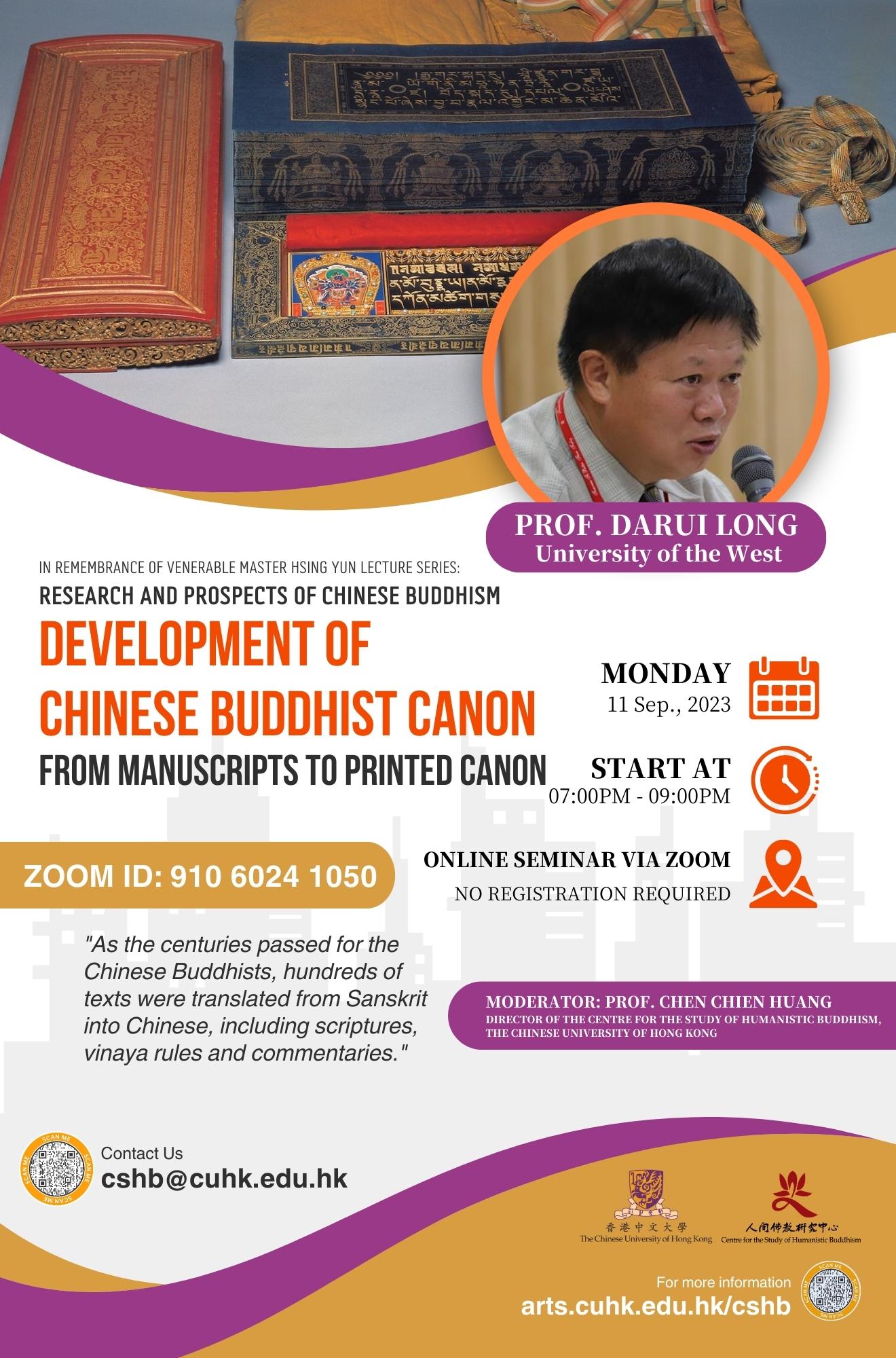活动
Development of Chinese Buddhist Canon: from Manuscripts to Printed Canon
2023年9月11日
19:00~21:00
Webinar
ZOOM Meeting ID: 910 6024 1050
Prof. Darui Long
University of the West
Dr. Darui Long earned his Ph.D. from Graduate School, Chinese Academy of Social Sciences, Beijing, 1996. Upon his graduation, he obtained a “Senior Fellowship” from Center for the Study of World Religions, Harvard University in 1996. The next year, he received a scholarship from Harvard-Yenching Institute. He received Princeton University Library Scholarship twice in 2009 and 2020 and visited Princeton University three times to examine its collections of Chinese Buddhist canon. He visited Jagiellonian University Library in Poland in three summer from 2016-2018 to investigate into its collection of Chinese Buddhist literature.
Dr. Long’s research interest is Chinese Buddhist canon, especially the Yongle Northern Canon constructed in Beijing from 1419-1440. He was editor-in-chief of the book Chinese Buddhist Canon in the Age of Printing, published by Routledge, UK, 2020. He is currently editor-in-chief of Chinese Buddhist Canon Research Newsletter initiated by Center for Buddhist Studies, University of Arizona, USA.
Dr. Long traveled widely in China, the US and Poland, visiting libraries, museums and temples. He has taken more than 40,000 photos worldwide for his research work. In 2017, he found one volume of Lotus Sutra in the Tangut (Xixia) language written on indigo paper with gold powder, Jagiellonian University Library. It is an invaluable treasure in the world and has aroused scholars’ great interest.
Currently, he is working on a concordant catalogue of Yongle Northern Canon with other editions of Chinese Buddhist canon. He has published many academic papers on Chinese Buddhist canon.
Online Seminar via ZOOM
NO REGISTRATION REQUIRED
When scholars check the history of how Buddhism spread in China, they immediately find out that the dissemination of Buddhist teachings has been closely tied to the scriptures and the translations of the many texts which contribute to it. As the centuries passed for the Chinese Buddhists, hundreds of texts were translated from Sanskrit into Chinese, including scriptures, vinaya rules and commentaries. The collected translations came to be considered as an entity and were called “yiqie jing” ( 一切經all scriptures), also called “Dazang jing” ( 大藏經Buddhist canon). In addition,a sizeable corpus of literature composed of the writings of learned monks and nuns within China was incorporated.
China has produced about 20 editions of Buddhist canon since the Emperor of Song dynasty began to use printing technology to engrave the first Chinese Buddhist canon in 971. This huge project involved engraving more than 130,000 woodblocks and it took thirteen years to accomplish it. This became a rule. When the country returned to peace and stability, the rulers would summon eminent Buddhist monks and scholars to edit and collate a new edition of Chinese Buddhist canon. Thus, copies of these editions of Buddhist canon became witness of the legitimacy of the dynasty, the development of Buddhism, the religious belief, the relations between the imperial court and Buddhism, even customs of the local people.
佛教大約在公元一世紀傳入中國,佛經的翻譯起了重要作用。數以百計的經文由梵文或中亞語言翻譯為中文,形成了經律論三藏為主的文獻,加上大量中國佛教徒的論述,稱之為“一切經”,或“大藏經”。宋太祖在開寶四年(971)下令用雕版技術刊刻大藏經,即《開寶藏》,刻了十二年,用了十三萬塊木板。從宋代起到近代,中國大約刊刻了二十多部大藏經。新的王朝建立後,國泰民安,統治者召集高僧和學者校點大藏經。這幾乎成為一種定式。 佛教大藏經見証了帝王的合法性、佛教的發展、宗教信仰、朝廷與佛教寺院的關係,甚至當地人民的習俗。
Language: English


